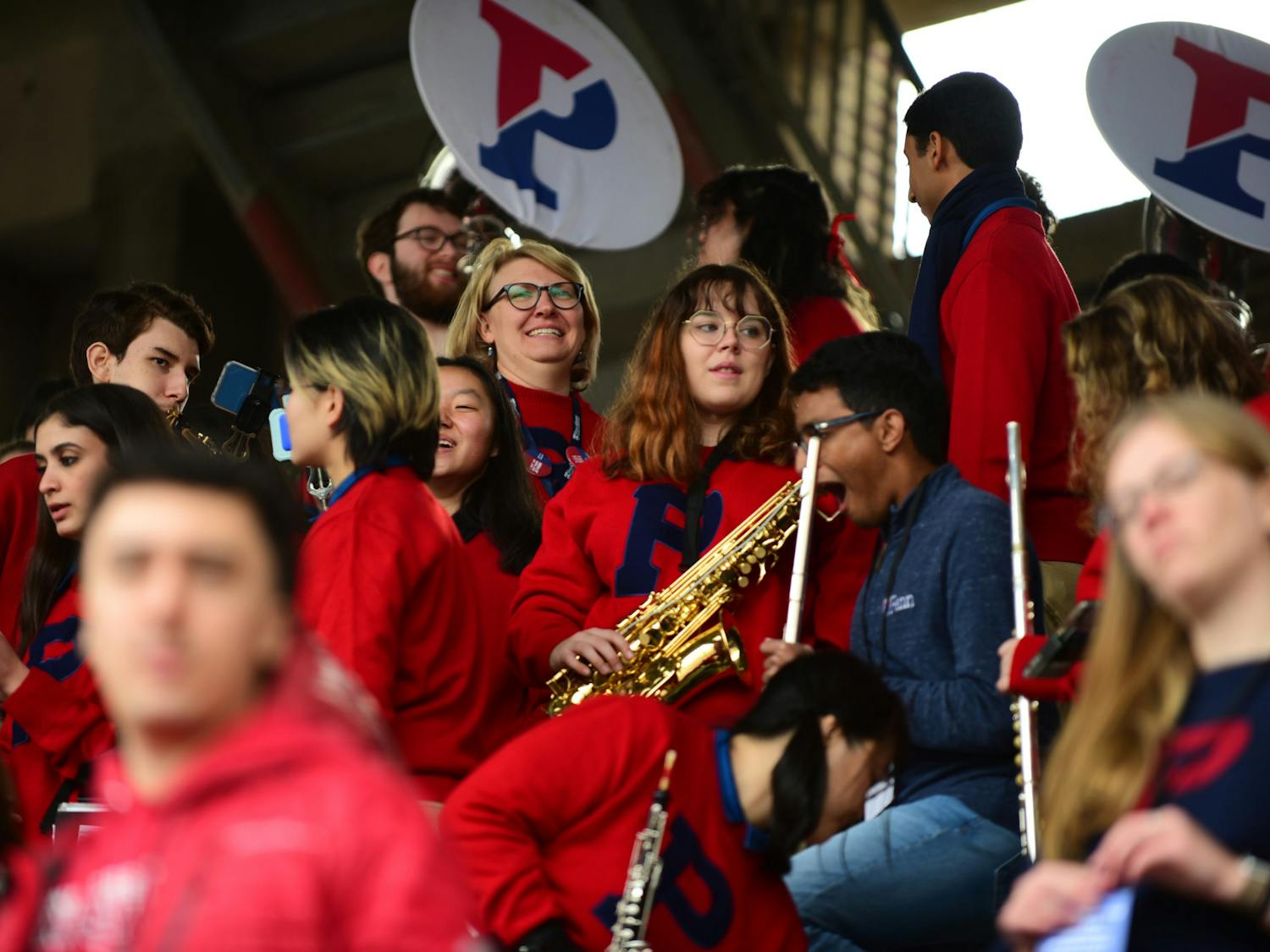How do we define free speech? How do we define how a university campus promotes, or discourages, free speech?
These are open questions, which have sparked discussion and debate in The Daily Pennsylvanian in light of recent on-campus protests, speaker events, and professor investigations.
Now more than ever, we must emphasize free speech and academic discourse on college campuses. Students should be aware of the University’s open expression guidelines and demand these rights be met. Dialogue on campus should not be dictated by anyone other than the students and faculty.
This week alone, Penn has been under fire for denying Penn Chavurah’s request to screen the documentary “Israelism,” and the Penn Middle East Center director has resigned in the wake of faculty concerns over academic freedom. Jared Taylor, a reported white nationalist who has been described as a promoter of eugenics and pseudoscience, spoke at a lecture taught by Professor Amy Wax at the Penn Carey Law School. His return as a guest speaker has reignited calls from student groups to fire Professor Wax.
There is one recurring statistic in our Opinion coverage that has often defined the state of free speech at Penn. According to FIRE — the Foundation for Individual Rights and Expression — Penn ranks second to last in campus free expression for the second year in a row.
It is a bold, provocative assertion to make, and fits well into the narrative of “woke ideology run amok” that is often told by politicians in America today. But FIRE’s 2024 rankings should be treated as more than a pithy soundbite that laments the death of free speech in “ivory tower” Ivy League schools like Penn. Instead, they should be held up under scrutiny and analyzed by conservatives and liberals alike in Penn’s community.
History of FIRE
FIRE was founded in 1999 by Penn history professor Alan Charles Kors and Boston civil liberties lawyer Harvey A. Silverglate after they co-authored “The Shadow University,” which critiqued attacks on freedom of speech on college campuses.
Kors attributes the founding of FIRE to his defense of Eden Jacobowitz in the 1993 “water buffalo case” at Penn, which he described as mishandled in a guest column for the Daily Pennsylvanian. This case, which garnered national news coverage, debated whether Jacobowitz had violated Penn’s racial harassment codes by calling five sisters of a traditionally Black sorority “water buffalo.” That same year, Kors worked with Penn’s Judicial Inquiry Office in 1993 to drop a case against Gregory Pavlik, a conservative columnist at the DP who wrote columns on racial issues on campus and was accused of 34 counts of racial harassment.
Though FIRE is purposefully nonideological and nonpartisan, its founding is tied to political backlash from the left in particular. FIRE has also been criticized for receiving significant donations from conservative and right-leaning groups like the the Lynde and Harry Bradley Foundation, the Sarah Scaife Foundation and the Charles Koch Institute, and this type of support has increased over time.
None of this information definitively labels FIRE as an institution with a political bent, but it is relevant context that should be examined. Given the causes that FIRE’s co-founder has supported in the past, and the organization’s ties to right-leaning organizations, we should take its prognoses with a grain of salt.
FIRE’s methodology
The methodology that FIRE uses to give Penn its dismal free speech ranking also deserves further examination.
The essence of FIRE’s ranking calculation comes from two sets of metrics. The first is a set of six components calculated from student surveys organized by College Pulse that assess perceptions of on-campus free speech. The sample size for Penn’s survey was 253 students, which is roughly 2.2% of undergraduate enrollment.
After these components are summed, the second set of metrics — behavior components — are incorporated through bonus and penalty points. Schools can lose points for sanctioning scholars, which is defined as either investigating, suspending, or terminating them. Scores for schools are then standardized, and schools may have standard deviations added or removed from that score based on FIRE’s rating of their speech code, which ranges from “green light” (+1 standard deviation) to “Warning” (-2 standard deviations).
It is unclear how free speech perceptions are weighed compared to concrete actions taken by campus communities, or how FIRE decided on this methodology to begin with. What counts as a “sanction” is similarly suspect. Two of the four most recent targeting incidents against professors at Penn that were labeled as “sanction” outcomes and thereby incorporated into the 2024 FIRE ranking concern Professor Wax.
As two Harvard Crimson columnists remark in their own analysis of FIRE’s rankings, “exercise of discretion to fire or hire scholars is an important form of free speech in and of itself,” and express that professors can be criticized for the offensive statements they make. It is important to remember that in the eyes of the FIRE free speech ranking, Penn is penalized for even considering whether or not to exercise this discretion in the case of Amy Wax.
The framing of Penn’s free speech, when compared to other universities, may also be misleading.
Take these two student voices from the FIRE rankings: one student is “worried for [their] grade when [they] might want to express an opinion that is different” and another “did not want the professor to fail [them] for thinking differently than them.” They sound near identical, but these students attend Penn and Michigan Technological University — ranked #1 in FIRE’s 2024 rankings — respectively.
Is it accurate to frame Penn as the second-worst university for free expression while it ranks higher than MTU on the “comfort expressing ideas” and “openness” axes of FIRE’s survey, and 55% of students at both schools say that they are worried about damaging their reputations if their words are misconstrued?
Many of the concerns that FIRE expresses concerning free speech are not isolated to Penn, or universities at the bottom of their ranking at all. While 30% of the surveyed Penn students state that “using violence to stop a campus speech” is at least rarely acceptable, 27% of all students across surveyed universities stated the same. 64% of Penn students stated that they self-censor at least once or twice a month on campus, while 58% of all students say the same.
These are not extreme differences. And yet, the quick-fire labeling of Penn’s state of free speech as second-worst has implied that there is something intrinsically different about how Penn handles open discourse compared to other universities.
Why FIRE’s ranking matters
Following recent controversy on Penn’s campus, it has not only been staff and guest columnists in our Opinion section that have seized on FIRE’s ranking. Both Marc Rowan and Jonathon Jacobson reference the ranking in their letters to Penn’s administration announcing their withdrawal of funding. It has also been repeatedly mentioned in media coverage from Fox News and the New York Post.
The 2024 FIRE free speech ranking is not objectively incorrect or meaningless. However, we must recognize that, as with any ranking and any methodology that accompanies it, there were deliberate choices made in how this information was obtained, analyzed, and presented to us. Objective data is a myth, and we discover that when we engage in nuanced discussion and ask questions about it.
The state of free speech at Penn cannot be encapsulated by a single number, and it is a disservice to treat it as such. We demand a more thoughtful examination of it from our readership and the media at large, and concrete actions from Penn’ administration to affirm a dedication to free speech on campus.
Editorials represent the majority view of members of The Daily Pennsylvanian, Inc. Editorial Board, which meets regularly to discuss issues relevant to Penn's campus. Editorial writers are not involved in any news reporting on related topics.









